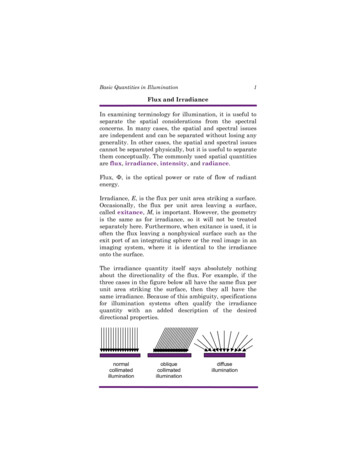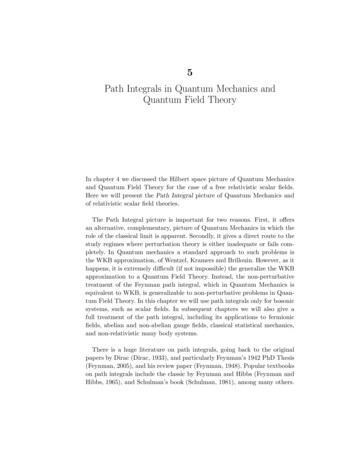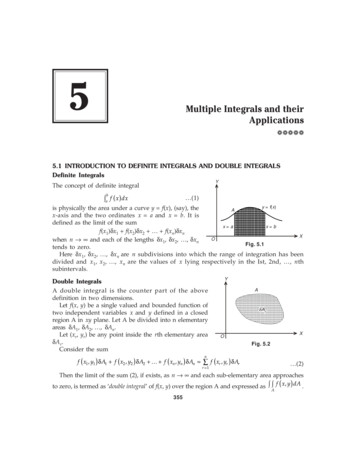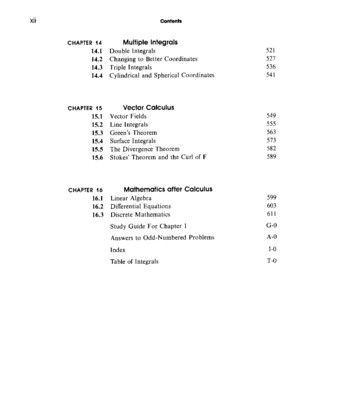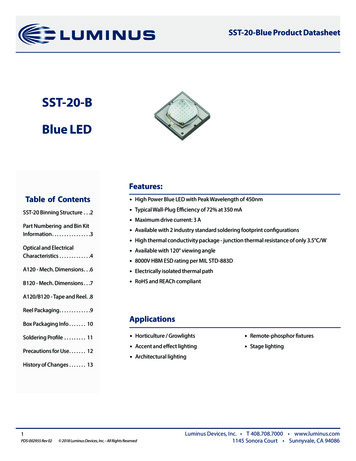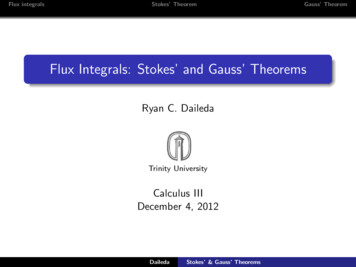
Transcription
Flux integralsStokes’ TheoremGauss’ TheoremFlux Integrals: Stokes’ and Gauss’ TheoremsRyan C. DailedaTrinity UniversityCalculus IIIDecember 4, 2012DailedaStokes’ & Gauss’ Theorems
Flux integralsStokes’ TheoremGauss’ TheoremSurfacesA surface S is a subset of R3 that is “locally planar,” i.e. when wezoom in on any point P S, S looks like a piece of a plane.DailedaStokes’ & Gauss’ Theorems
Flux integralsStokes’ TheoremGauss’ TheoremOrientable surfacesA surface S is orientable if it is “two sided.”Every surface shown above is orientable.The Möbius band is not orientable.If S is an oriented surface, an orientation of S is a choice of aparticular side of S as “positive.”DailedaStokes’ & Gauss’ Theorems
Flux integralsStokes’ TheoremGauss’ TheoremPlanar fluxIf S is an oriented (finite) part of a plane and F ai bj ck is aconstant vector field, the flux of F through S is defined to becompn (F) A(S)where:n is the normal vector to S, in the “positive” direction;A(S) is the area of S.If F represents the “flow” of some quantity, then the flux is theamount of “stuff” that passes through S in one unit of time.DailedaStokes’ & Gauss’ Theorems
Flux integralsStokes’ TheoremGauss’ TheoremGeneral fluxSuppose S is a more general oriented surface, and F F(x, y , z) isa possibly nonconstant vector field.Subdivide S into (approximately) planar pieces with(inherited) normal vectors nj and areas Sj .Choose a point Pj in the jth subdivision, and assume thatF F(Pj ) throughout this subdivision.Compute the “local planar flux” on each subdivision and addto get the total approximate flux:Xcompnj (F(Pj )) Sj .jTake the limit as the areas of the subdivisions tend to zero toget the flux of F through S:ZZXF · dS limcompnj (F(Pj )) Sj .S S 0DailedajStokes’ & Gauss’ Theorems
Flux integralsStokes’ TheoremGauss’ TheoremRemarksIf we assume that nj is a unit vector, thencompnj (F(Pj )) Sj (F(Pj ) · nj ) Sj F(Pj ) · ( Sj nj ) F(Pj ) · Sj ,where Sj is a normal vector with area Sj .The dS is thus meant to represent an “infinitesimal areanormal vector” to S.As with planarRRflux, if F represents the “flow” of somequantity, then S F · dS represents the amount of “stuff” thatpasses through S in one unit of time.DailedaStokes’ & Gauss’ Theorems
Flux integralsStokes’ TheoremGauss’ TheoremComputing flux integralsRRIn order to compute S F · dS, one must first parametrize S via atwo-variable vector function:r(u, v ) x(u, v )i y (u, v )j z(u, v )k, (u, v ) D R2 .If we define x r i u u r xTv i v vTu yj u yj v zk, u zk vthen Tu Tv is normal to S at every point. If the direction of nagrees with the orientation of S, a Riemann sum argument showsZZZZF(r(u, v )) · (Tu Tv ) du dv .F · dS SDDailedaStokes’ & Gauss’ Theorems
Flux integralsStokes’ TheoremGauss’ TheoremExampleFind the flux of the vector fieldF xi zj y kthrough the portion of the sphere x 2 y 2 z 2 4 in the firstoctant, oriented toward the origin.The portion of the sphere in question can be parametrized asr(u, v ) 2 sin u cos v i 2 sin u sin v j 2 cos u k,0 u π/2, 0 v π/2.The tangent vectors areTu 2 cos u cos v i 2 cos u sin v j 2 sin u k,Tv 2 sin u sin v i 2 sin u cos v j.DailedaStokes’ & Gauss’ Theorems
Flux integralsStokes’ TheoremGauss’ TheoremWe haveTu Tv 4 sin2 u cos v i 4 sin2 u sin v j 4 sin u cos u kandF(r(u, v )) 2 sin u cos v i 2 cos u j 2 sin u sin v k,so thatF · (Tu Tv ) 8 sin3 u cos2 v .Since Tu Tv is oriented outward we haveZZSF · dS Z0π/2Z π/28 sin3 u cos2 v du dv 0DailedaStokes’ & Gauss’ Theorems4π3
Flux integralsStokes’ TheoremGauss’ TheoremA relationship between surface and line integralsStokes’ TheoremLet S be an oriented surface bounded by a closed curve S. If F isa C 1 vector field and S is oriented positively relative to S, thenZZZF · dr. F · dS SSnS SDailedaStokes’ & Gauss’ Theorems
Flux integralsStokes’ TheoremGauss’ TheoremRemarksStokes’ Theorem is another generalization of FTOC. It relatesthe integral of “the derivative” of F on S to the integral of Fitself on the boundary of S.If D R2 is a 2D region (oriented upward) and F Pi Qjis a 2D vector field, one can show thatZZZZ P Q dA. F · dS yD xDThat is, Stokes’ Theorem includes Green’s Theorem as aspecial case.DailedaStokes’ & Gauss’ Theorems
Flux integralsStokes’ TheoremGauss’ TheoremInterpreting the curlLet F be a vector field. Fix a point P R3 and a unit vector nbased at P. Let Ca denote a circle of radius a, centered at P0 , inthe plane normal to n, oriented using the right hand rule.naPCaThe tendency of F to “circulate” about n (in the positive sense)can be measured byZ1F · dr.lima 0 πa2 CaDailedaStokes’ & Gauss’ Theorems
Flux integralsStokes’ TheoremGauss’ TheoremIf Da is the disk bounded by Ca , Stokes’ Theorem impliesZZZ11lim 2F · dr lim 2 F · dSa 0 πaa 0 πaCaDa1 lim 2 ( F)(P0 ) · n A(Da )a 0 πa ( F)(P0 ) · n.Thus, the circulation at P about n is maximized when n points inthe same direction as F.DailedaStokes’ & Gauss’ Theorems
Flux integralsStokes’ TheoremGauss’ TheoremA relationship between surface and triple integralsGauss’ Theorem (a.k.a. The Divergence Theorem)Let E R3 be a solid region bounded by a surface E . If F is aC 1 vector field and E is oriented outward relative to E , thenZZZZZF · dS. · F dV EE EDailedaStokes’ & Gauss’ Theorems
Flux integralsStokes’ TheoremGauss’ TheoremRemarksThis can be viewed as yet another generalization of FTOC.Gauss’ Theorem reduces computing the flux of a vector fieldthrough a closed surface to integrating its divergence over theregion contained by that surface.As above, this can be used to derive a physical interpretationof · F:ZZZ1( · F)(P) lim · F dVa 0 V (Ba )BaZZ1 lim F · dS,a 0 V (Ba )Sawhere P R3 , Ba and Sa are the solid ball and sphere(respectively) of radius a centered at P.DailedaStokes’ & Gauss’ Theorems
Flux integralsStokes’ TheoremGauss’ TheoremA vast generalizationWe have studied various types of differentiation andintegration in 2 and 3 dimensions.These can be generalized to arbitrary dimension n using thenotions of “manifold” and “differential form.”The following theorem unifies and extends much of ourintegration theory in one statement.Generalized Stokes TheoremIf M is an n-dimensional “manifold with boundary,” and ω is a“differential (n 1)-form,” thenZZω.dω MDaileda MStokes’ & Gauss’ Theorems
a denote a circle of radius a, centered at P0, in the plane normal to n, oriented using the right hand rule. n P a Ca The tendency of Fto "circulate" about n(in the positive sense) can be measured by lim a 0 1 πa2 Z Ca F·dr. Daileda Stokes' &Gauss'Theorems



